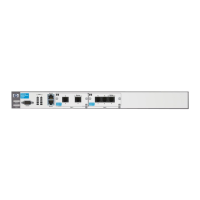8-42
Configuring Demand Routing for Primary ISDN Modules
Using Demand Routing for ISDN Connections
If your public carrier is using the default signaling type, you do not have to
enter the isdn switch-type command. You can simply accept the default
setting.
Configuring a SPID and LDN for ISDN BRI U Modules
In North America, some ISDN switches require a SPID to identify each TE on
the subscriber’s premises and to determine the types of services that the TE
can access. A SPID is typically a 14-digit number that includes the interface’s
10-digit telephone or local directory number (LDN) and a two- to four-digit
identifier. This identifier specifies the type of service on the line (data or
voice). If the public carrier’s switch requires a SPID, you must specify it when
you set up your ISDN equipment.
If you are configuring a router for an ISDN connection in North America, enter
the following command to set the SPID:
Syntax: isdn spid1 <SPID1>
Some public carriers assign two SPIDs to ISDN connections that use both
channels. You must set the second SPID in order for the second B channel to
properly receive data. You set the second SPID using the isdn spid2
command:
Syntax: isdn spid2 <SPID2>
You can set a SPID and an LDN in one command. Enter:
Syntax: isdn spid1 <SPID1> <LDN1>
For example, you might enter:
ProCurve(config-bri 1/3)# isdn spid1 70455511110101 5555551111
Similarly, you can set a second LDN at the same time that you set the
second SPID.
ProCurve(config-bri 1/3)# isdn spid2 70455511120101 5555551112
Alternatively, you can set an LDN using a separate command.
Syntax: isdn ldn1 <LDN1>
Syntax: isdn ldn2 <LDN2>

